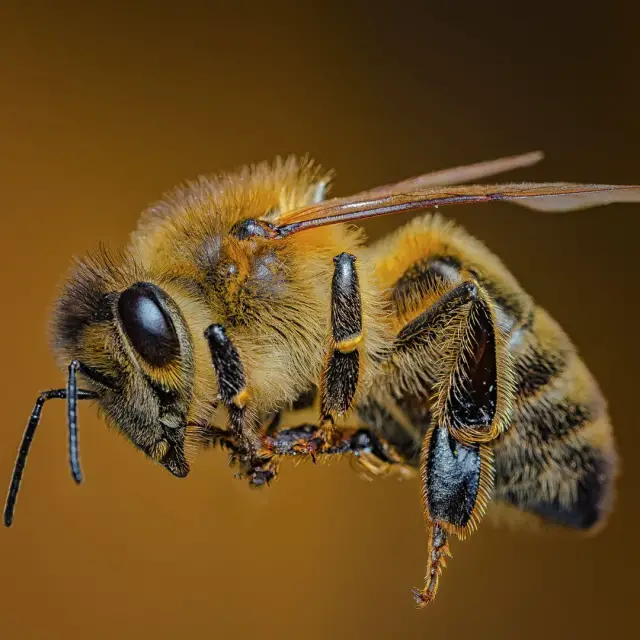Bee stings are a recurring theme in everyday life, especially in warmer weather when bees are active pollinating flowers and plants. Although bee stings are relatively common, in certain cases they can be serious, especially for people with allergies.
What happens during a bee sting?
When a bee stings, it usually does so in self-defense. Worker bees have a stinger that they use as a defense mechanism when they feel threatened. This stinger contains venom, which is what produces the reaction in the human body.
The stinger is connected to a venom sac in the bee's abdomen. When the bee stings, the stinger becomes embedded in the person's skin and the venom is released. In doing so, the bee, especially honey bees, causes its own death, as the stinger is torn off along with part of its abdomen.
The venom released by the bee contains proteins that affect skin cells and the immune system, causing pain and swelling in the affected area. In non-allergic people, this may be a temporary inconvenience, but in allergic individuals, the situation can become much more serious.
Common symptoms of a bee sting
The initial reaction after a bee sting is usually quite immediate. Most people experience a local reaction that includes:
Sharp or stabbing pain at the site of the bite.
Redness around the affected area.
Mild to moderate swelling.
Itching or burning sensation.
In some cases, a small blister or swollen area may appear.
These symptoms usually last a few hours and, in most cases, resolve without complications. However, the intensity of the reaction can vary from person to person, depending on individual sensitivity and the number of bites received.
Allergic Reactions: When to Worry?
For some people, bee stings can trigger a severe allergic reaction, known as anaphylaxis. This is a life-threatening condition that requires immediate medical attention. Symptoms of an anaphylactic reaction include:
Difficulty breathing or wheezing.
Swelling of the tongue, lips, or throat.
Dizziness or fainting.
Rapid or irregular heartbeats.
Nausea, vomiting, or diarrhea.
Skin rash or hives that spreads beyond the bite area.
If a person experiences any of these symptoms after being stung by a bee, they should seek urgent medical attention, as anaphylaxis can progress rapidly. Individuals with known allergies to bee stings often carry an epinephrine auto-injector, such as the EpiPen, which can be life-saving by delivering a dose of adrenaline to counteract the effects of the allergic reaction.
First aid after a bee sting
For people who are not allergic, a bee sting can be treated at home with simple measures. Here are the basic steps to follow:
Removing the stinger: The first and most important thing is to remove the stinger from the skin as soon as possible, as the longer the stinger remains, the more venom will be released. Use a flat object, such as a credit card, to scrape the stinger away rather than pinching it, as this can inject more venom.
Wash the affected area: Gently wash the area with soap and water to prevent infection.
Apply ice: Place an ice pack or cold cloth on the bite to reduce swelling and relieve pain.
Taking antihistamines: If the bite causes itching or swelling, antihistamines such as diphenhydramine (Benadryl) may help reduce the allergic response.
Using topical creams: Applying a corticosteroid cream or calamine lotion can relieve itching and inflammation.
Elevate the affected area: If the bite is on an extremity, keeping it elevated can help reduce swelling.
Natural treatments for bee stings
In addition to conventional medical treatments, many people turn to natural remedies to relieve the symptoms of a bee sting. Some of these include:
Aloe vera: The gel from this plant has anti-inflammatory properties that can soothe irritated skin and speed up the healing process.
Honey: Ironically, honey, which comes from bees, is known for its antibacterial and soothing properties. Applying a small amount to the bite can help reduce inflammation.
Baking soda: A paste of baking soda and water can neutralize the venom from the bite and reduce the pain.
Apple cider vinegar: Apple cider vinegar is said to neutralize the toxins in the venom and relieve itching.
Lavender or tea tree oil: Both essential oils have soothing and antibacterial properties that can help reduce inflammation and prevent infection.
Preventing bee stings
The best way to avoid the effects of a bee sting is to prevent it from happening in the first place. Here are some tips to reduce your risk of being stung:
Avoid perfumes and bright colors: Bees are attracted to floral fragrances and bright colors, so it is advisable to avoid these items if you are going to be in areas where bees are present.
Wear appropriate clothing: If you are going to be outdoors, wear clothing that covers most of your body. You can also opt for light colors, since bees are more attracted to dark tones.
Don't disturb the bees: Avoid making sudden movements or trying to scare a bee away. Stay calm and move slowly.
Keep food and drinks covered: Bees are attracted to sweet foods and drinks, especially during a picnic or cookout.
Don't walk barefoot: Many bee stings occur when people inadvertently step on a bee. Wear shoes when outdoors.
When to see a doctor?
In most cases, a bee sting does not require medical attention. However, you should seek professional help if:
You experience symptoms of a severe allergic reaction (anaphylaxis).
Swelling extends beyond the bite area.
The bite becomes infected, which may manifest as redness, warmth, or pus.
You have been stung multiple times, as the accumulated venom can be more dangerous.
Bee stings are a natural part of life in the wild, and while in most cases they are not serious, they can cause temporary discomfort. For those with allergies, it is important to take precautions and be prepared in case of a sting. By knowing the symptoms, treatments, and preventative measures, it is possible to reduce the risks and discomfort associated with these outdoor encounters.
